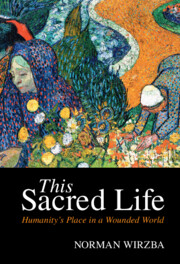Book contents
- This Sacred Life
- Reviews
- This Sacred Life
- Copyright page
- Dedication
- Epigraph
- Contents
- Preface
- Acknowledgments
- Part I Assessing Our Situation
- Part II Turning to Fundamentals
- Part III This Sacred Life
- 5 Why Sacred Anything?
- 6 The Logic of Creation
- 7 Creaturely Humanity
- 8 Called to Creativity
- Author Index
- Scripture Index
- Subject Index
8 - Called to Creativity
from Part III - This Sacred Life
Published online by Cambridge University Press: 08 October 2021
- This Sacred Life
- Reviews
- This Sacred Life
- Copyright page
- Dedication
- Epigraph
- Contents
- Preface
- Acknowledgments
- Part I Assessing Our Situation
- Part II Turning to Fundamentals
- Part III This Sacred Life
- 5 Why Sacred Anything?
- 6 The Logic of Creation
- 7 Creaturely Humanity
- 8 Called to Creativity
- Author Index
- Scripture Index
- Subject Index
Summary
One of the most destructive features of modern life is to deprive people of the sense that they are essentially creative beings. The industrialization and commercialization of work have a lot to do with this, but so too does the elevation of the fine artist as a lonely (often tortured) genius, and the reduction of people to passive consumers. In this chapter, Wirzba gives an account of good work as an indispensable means through which people contribute to the making of a beautiful world and thriving communities. To be creative is to respond to the sanctity of fellow creatures with the skill and devotion that contribute to shared flourishing. But for people to be creative in this way, the personal, social, economic, and political contexts through which they live need to be properly cultivated. The highest form of creativity is to focus and train one’s love into practical skills that join with the sacred love that is already at work in the world.
Keywords
- Type
- Chapter
- Information
- This Sacred LifeHumanity's Place in a Wounded World, pp. 212 - 254Publisher: Cambridge University PressPrint publication year: 2021

